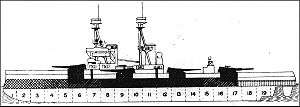Bellerophon-class battleship
 | |
| Class overview | |
|---|---|
| Operators: |
|
| Preceded by: | HMS Dreadnought |
| Succeeded by: | St. Vincent class |
| Cost: | about £1,600,000 plus £116,300 for guns |
| Built: | 1906–09 |
| In service: | 1909–21 |
| In commission: | 1909–21 |
| Completed: | 3 |
| Retired: | 3 |
| General characteristics | |
| Type: | Dreadnought battleship |
| Displacement: |
|
| Length: | 160.3 m (526 ft) overall |
| Beam: | 25.2 m (83 ft) |
| Draught: | 8.3 m (27.2 ft) |
| Propulsion: |
|
| Speed: |
|
| Range: | 5,720 nmi (10,590 km) at 10 knots (19 km/h) |
| Complement: | 733 |
| Armament: |
|
| Armour: |
|
The Bellerophon class was a class of three dreadnought battleships that were built in the United Kingdom prior to World War I, and served in the Royal Navy during the war. The Bellerophons were based on the previous HMS Dreadnought, with a second tripod mast and other changes. The lead ship, HMS Bellerophon, was laid down on the same day of Dreadnought's final completion, which was also built at Portsmouth Dockyard.
Design

Changes to the hull gave a more complete internal protection and allowed the larger ships to make the same speed with the same powerplant. While Dreadnought had bulkheads that protected only the magazines, the Bellerophons had complete bulkheads running longitudinally through the ship. The 12-pounder guns that had been added to Dreadnought for protection from torpedo boats were recognised as being insufficient and their secondary armament was made up of 4-inch (102 mm) guns. A mainmast added ahead of the aft funnel was still affected by the plume of the fore funnel and was not considered a success. These changes did require some compromises in the design resulting in thinner armour, reducing the belt armor from 11 to 10 inches (254 mm), and a reduced coal bunkerage, which limited the steaming endurance.
General characteristics
The Bellerophon's design was virtually identical to that of the preceding Dreadnought, with some minor improvements.[1] The tripod foremast, which on Dreadnought was behind the forward funnel, was positioned in front of the forward funnel so that lookouts stationed on the observation platform could be out of the smoke plume.[1] A second tripod mast was placed in front of the second funnel.[2]
The ships of the Bellerophon class were 160.3 m (526 ft) long. They had a beam of 25.2 m (83 ft), a draught of 8.3 m (27 ft), and normally displaced 18,800 tonnes with a maximum displacement of 22,102 tonnes.[3]
Propulsion
The Bellerophon class had the same propulsion design as the previous Dreadnought. The ships were powered by four-shaft Parsons turbines in 18 coal-fired boilers. The ships' powerplants delivered at a rated 23,000 shp.[4]
Armament
The Bellerophon's armament featured an improved second battery. Sixteen 4 in (10 cm) guns replaced the twenty-seven 3 in (7.6 cm) guns on Dreadnought. However, the main armament was the same having ten 12 in (30 cm) guns in five twin turrets.[3]
Construction
| Ship | Builder | Engine builder | Laid down | Launched | Commissioned | Cost according to | |
|---|---|---|---|---|---|---|---|
| HMS Bellerophon | Portsmouth Dockyard, Portsmouth, England | Fairfield Shipbuilding and Engineering Company, Parsons turbines |
6 December 1906 | 27 July 1907 | 20 February 1909[1] | ||
| HMS Superb | Armstrong Elswick Works, Newcastle upon Tyne, England | Wallsend Co., Parsons turbines |
6 February 1907 | 7 November 1907 | 9 June 1909[1] | ||
| HMS Temeraire | Devonport Dockyard, Plymouth, England | Hawthorn Leslie and Company, Parsons turbines |
1 January 1907 | 24 August 1907 | 15 May 1909[1] | ||
Footnotes
References
- Gardiner, Robert; Gray, Randal, eds. (1984). Conway's All the World's Fighting Ships: 1906–1922. Annapolis: Naval Institute Press. ISBN 0-87021-907-3.
- Miller, David (2001). Illustrated Directory of Warships of the World. Osceola: Salamander Books. ISBN 0-7603-1127-7.
External links
| Wikimedia Commons has media related to Bellerophon class battleship. |
- World War I Naval Combat - HMS Bellerophon
- MaritimeQuest Bellerophon Class Overview
- Dreadnought Project Technical material on the weaponry and fire control for the ships